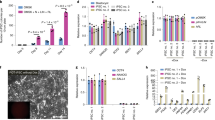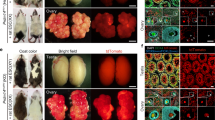Abstract
Induced pluripotent stem cells (iPSCs) are considered to be an attractive alternative to embryonic stem cells (ESCs) and may provide great potential for clinical applications in regenerative medicine. Although possessing characteristics similar to ESCs, the true pluripotency of these newly studied iPSCs was not known because none of the previously developed iPSCs passed the tetraploid complementation assay, which is regarded as the most stringent test for pluripotency. We have recently shown that by modifying some of the culture conditions for inducing iPSCs, we were able to generate cell lines of high pluripotency, resulting in the production of live-born, fertile animals through tetraploid complementation. In this paper, we describe details of our methods of generating iPS cell lines and subsequently producing full-term live animals through the tetraploid complementation assay; the procedure can be completed within 2 months.
This is a preview of subscription content, access via your institution
Access options
Subscribe to this journal
Receive 12 print issues and online access
$259.00 per year
only $21.58 per issue
Buy this article
- Purchase on Springer Link
- Instant access to full article PDF
Prices may be subject to local taxes which are calculated during checkout



Similar content being viewed by others
References
Takahashi, K. & Yamanaka, S. Induction of pluripotent stem cells from mouse embryonic and adult fibroblast cultures by defined factors. Cell 126, 663–676 (2006).
Yamanaka, S. Ekiden to iPS cells. Nat. Med. 15, 1145–1148 (2009).
Saha, K. & Jaenisch, R. Technical challenges in using human induced pluripotent stem cells to model disease. Cell Stem Cell 5, 584–595 (2009).
Takahashi, K., Okita, K., Nakagawa, M. & Yamanaka, S. Induction of pluripotent stem cells from fibroblast cultures. Nat. Protoc. 2, 3081–3089 (2007).
Nagy, A., Rossant, J., Nagy, R., Abramow-Newerly, W. & Roder, J.C. Derivation of completely cell culture-derived mice from early-passage embryonic stem cells. Proc. Natl. Acad. Sci. USA 90, 8424–8428 (1993).
Wang, Z.Q., Kiefer, F., Urbanek, P. & Wagner, E.F. Generation of completely embryonic stem cell-derived mutant mice using tetraploid blastocyst injection. Mech. Dev. 62, 137–145 (1997).
Wang, Z. & Jaenisch, R. At most three ES cells contribute to the somatic lineages of chimeric mice and of mice produced by ES-tetraploid complementation. Dev. Biol. 275, 192–201 (2004).
Meissner, A., Wernig, M. & Jaenisch, R. Direct reprogramming of genetically unmodified fibroblasts into pluripotent stem cells. Nat. Biotechnol. 25, 1177–1181 (2007).
Jaenisch, R. & Young, R. Stem cells, the molecular circuitry of pluripotency and nuclear reprogramming. Cell 132, 567–582 (2008).
Zhao, X.Y. et al. iPS cells produce viable mice through tetraploid complementation. Nature 461, 86–90 (2009).
Boland, M.J. et al. Adult mice generated from induced pluripotent stem cells. Nature 461, 91–94 (2009).
Kang, L., Wang, J., Zhang, Y., Kou, Z. & Gao, S. iPS cells can support full-term development of tetraploid blastocyst-complemented embryos. Cell Stem Cell 5, 135–138 (2009).
Cheng, J., Dutra, A., Takesono, A., Garrett-Beal, L. & Schwartzberg, P.L. Improved generation of C57BL/6J mouse embryonic stem cells in a defined serum-free media. Genesis 39, 100–104 (2004).
Eakin, G.S. & Hadjantonakis, A.K. Production of chimeras by aggregation of embryonic stem cells with diploid or tetraploid mouse embryos. Nat. Protoc. 1, 1145–1153 (2006).
Blelloch, R., Venere, M., Yen, J. & Ramalho-Santos, M. Generation of induced pluripotent stem cells in the absence of drug selection. Cell Stem Cell 1, 245–247 (2007).
Yoshimizu, T. et al. Germline-specific expression of the Oct-4/green fluorescent protein (GFP) transgene in mice. Dev. Growth Differ. 41, 675–684 (1999).
Kirchain, S.M., Hayward, A.M., Mkandawire, J.M., Qi, P. & Burds, A.A. Comparison of tetraploid blastocyst microinjection of outbred Crl:CD1(ICR), hybrid B6D2F1/Tac, and inbred C57BL/6NTac embryos for generation of mice derived from embryonic stem cells. Comp. Med. 58, 145–150 (2008).
Acknowledgements
This study was supported in part by grants from China National Basic Research Program 2006CB701500 (to Q.Z.) and 2007CB947800 (to F.Z.).
Author information
Authors and Affiliations
Contributions
Q.Z. and F.Z. designed the experiments, supervised the work, analyzed and interpreted data and wrote the manuscript. X.Z., W.L. and Z.L. performed the experiments and contributed to part of the manuscript.
Corresponding authors
Ethics declarations
Competing interests
The authors declare no competing financial interests.
Rights and permissions
About this article
Cite this article
Zhao, XY., Lv, Z., Li, W. et al. Production of mice using iPS cells and tetraploid complementation. Nat Protoc 5, 963–971 (2010). https://doi.org/10.1038/nprot.2010.61
Published:
Issue Date:
DOI: https://doi.org/10.1038/nprot.2010.61
This article is cited by
-
A single-cell identification and capture chip for automatically and rapidly determining hydraulic permeability of cells
Analytical and Bioanalytical Chemistry (2020)
-
Derivation and application of pluripotent stem cells for regenerative medicine
Science China Life Sciences (2016)
-
Some Ethical Concerns About Human Induced Pluripotent Stem Cells
Science and Engineering Ethics (2016)
-
Techniques of Human Embryonic Stem Cell and Induced Pluripotent Stem Cell Derivation
Archivum Immunologiae et Therapiae Experimentalis (2016)
-
Mechanisms and models of somatic cell reprogramming
Nature Reviews Genetics (2013)
Comments
By submitting a comment you agree to abide by our Terms and Community Guidelines. If you find something abusive or that does not comply with our terms or guidelines please flag it as inappropriate.



